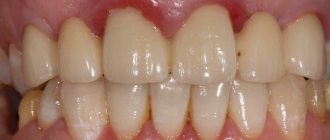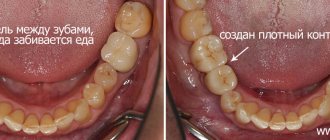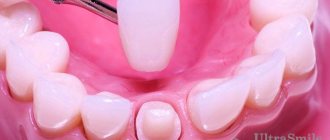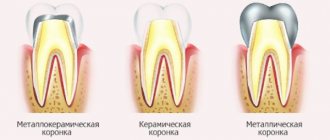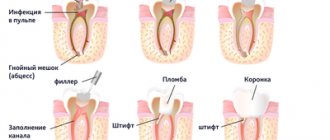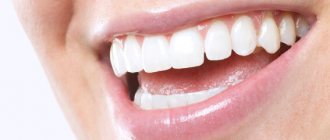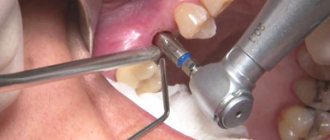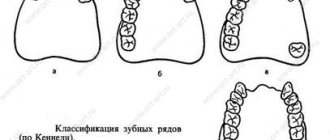- Service life of different types of crowns
- Late crown replacement
- When to change a crown
- How to change crowns
- How often are crowns replaced?
- Additional videos
Sooner or later, most people have to deal with dental prosthetics.
Perhaps the most common type of prosthetics is the so-called “dental crown” (more information about different crowns here). Many patients are their owners, but only a few patients ask questions: do dental crowns need to be replaced, how often should dental crowns be changed, etc.
Let's try to figure it out.
What is the service life of different types of crowns?
As you know, any structure has a certain service life. Unnecessarily long use can lead to dire consequences.
So: how often should crowns be replaced?
It is believed that the average service life of a crown is 5-7 years. At one time, scientists proved that it is after such a period of time that the cement on which the crown is fixed begins to undergo changes. But this does not mean that the crown must be changed every 5 or 7 years. During this period, a doctor should evaluate it to understand whether it can still serve or whether the crown needs to be replaced.
In addition to the duration of use, during a preventive examination, the doctor evaluates the following parameters: the quality of the marginal fit of the crown to the tooth, the condition of the gums and bone tissue next to the crown, X-ray data of the tooth, patient complaints, etc.
Temporary cement
Several teeth ached during prosthetics. The doctor said that I should wear metal-ceramic crowns with temporary cement for a while. Can you tell me how long I can wear crowns with temporary cement without damaging my teeth? What measures should be taken for prevention?
Temporary dental crowns are usually secured by dentists in your mouth with “temporary” cement so that they can be easily removed the next time you visit the dentist.
Yes of course. Because this cement is not as strong as cement for permanent crowns. Didn’t your doctor advise you what precautions you should take so as not to “rip off” your temporary crown?
Yes, the fact of the matter is that it doesn’t. That’s what she said in general terms... to use this side less and that’s all. And I’m sitting and don’t know what else can be done to avoid unpleasant consequences...
Well, in general, for this purpose, doctors usually advise chewing as little as possible on the side of the mouth where the temporary crown is installed. To avoid any trouble, limit the stress on your temporary crown while eating.
The advice is correct. Simply move - as much as possible - your "chewing activity" to the other side of your mouth. You should also not chew sticky food on the same side where the temporary crown is installed.
Sorry, I misunderstood a little. What do you mean by the term “sticky food”? What applies to it and what else should I not do with my temporary filling?
It's simple. Sticky foods include candy and chewing gum. You should not use them because they can stick to your temporary crown and simply “pull” it off the tooth.
Doctors also advise you not to chew very hard food on the side where the temporary crown is installed. Because if you chew hard food with a temporary crown, it may come off the tooth or even break - it is also temporary.
And of course, be careful when using a regular toothbrush or floss on the side of your mouth where the temporary crown is installed.
If the temporary crown does come off the tooth, then you just need to put the slipped crown back in place. This will protect the tooth from external irritants - cold and hot food. If, after inserting the crown into place and closing your jaws, you feel that the crown is bothering you, then you need to remove it and consult a doctor.
I heard about the temporary installation of crowns on weaker cement, but I still did not understand why the patient should be tormented by this, and why it is impossible to immediately install permanent crowns on normal cement. After all, you must admit that eating crowns is an unpleasant thing.
After grinding the teeth, it is necessary to use temporary artificial crowns, which protect the operated hard tissues of the tooth from environmental influences and prevent the development of inflammatory changes in the pulp.
Our dentists do not use temporary crowns. If a tooth is ground today, then, at best, tomorrow or the day after tomorrow they will put in a permanent one. And all this time, the ground tooth reacts painfully to cold and hot, transmitting its sensations to the gum.
Do your doctors still treat teeth in the primitive way? After all, leaving teeth uncoated after grinding is a thing of the past. This is pain with cold and hot food, even just pain from cold air in winter. Temporary crowns allow you to avoid all this before installing a permanent one.
What determines the service life of a crown?
- The service life and the need to replace the structure greatly depend on the accuracy of manufacturing at all stages. Precision work means that the crown fits to the tooth without gaps, without steps, without voids, oral fluid and food do not get under it, the gums around it do not become inflamed, it is no different from the “native” tooth. It is the precision of manufacturing that determines the quality of work, and therefore is the key to a long service life of the crown. For example, I had to deal with a situation where the crown was made only a year ago, and upon examination, strict indications for its urgent replacement were revealed (due to poor quality, namely inaccurate manufacturing). And vice versa, when examined, the crown meets all the requirements, all parameters are normal, there is no need to replace it, and it has been standing for 10 years (which means it was manufactured very accurately and in a timely manner).
- We have repeatedly mentioned that accuracy, and therefore quality, is at the forefront. If we take quality as a given, then the material and method of fixation come to the fore. So, the service life also depends on the material from which the crown is made and, accordingly, on the method of fixing it to the tooth . Classic metal-ceramics and zirconium dioxide-based crowns are attached to a special “cement,” that is, an intermediary between the crown and the tooth, and do not enter into a “chemical” bond with either this cement or the ground tooth. Namely, this cement is “destroyed” and “washed out” over time, leading to a violation of the seal of the entire structure. Crowns based on lithium disilicate (also called “E-max”) are fixed without an intermediary: using the adhesive (“glue”) method, that is, they are glued to the tooth tissue, which leads to a very strong connection between the crown and the tooth. Accordingly, the service life of such structures is longer than the 5-7 years described above, which means that a crown change will not be required soon.
- In addition, the service life is greatly influenced by the condition of the tooth for which the crown was made. If a patient hesitates for a long time to adequately restore a damaged tooth, he comes for prosthetics at an untimely rate, in particular when the tooth is destroyed by a carious process to the level or below the level of the gum, becoming “soft” and unreliable. In such conditions, the doctor is no longer able to make an accurate marginal fit; such a structure will never be completely sealed, which means the tooth under such a crown will be destroyed. In such conditions, neither good materials nor the method of fixing the crown will help. And if the doctor nevertheless undertakes the restoration of such a tooth, this will be the last crown on it, since it will be impossible to repeat the restoration.
Important! Dear patients, do not delay the restoration of damaged teeth, do not deprive yourself of the opportunity to save your own tooth faster, more reliably and cheaper!
By clicking on the “Make an appointment” button, I consent to the processing of my personal data.
I have read and agree with the conditions for processing personal data set out on the website ds-chocolate.ru.
Consent to the processing of personal data
How long does it take to install a temporary crown on a tooth?
Plastic crowns perform several functions:
- restores the function of a ground tooth;
- mask dental defects;
- facilitate the process of getting used to a permanent crown;
- allows you to maintain acceptable diction;
- protects soft tissues from infection;
- prevent malocclusion and prevent neighboring teeth from taking up free space.
Features of installation on the front and chewing teeth
When replacing incisors and canines with prosthetics, it is especially important that the result of the work is aesthetic, since these teeth are located in the smile zone. Therefore, in this case, only the indirect method of making crowns is suitable. In addition, you should pay attention to ensure that the color of the material matches the natural enamel of adjacent teeth.
Molars bear the majority of the chewing load. Therefore, temporary crowns in the area of these teeth quickly wear out, crack and wear out. Therefore, if such crowns have to be worn longer than expected, then it is better to give preference to metal models lined with plastic.
At your appointment, the dentist will tell you what material is best to make the crown from. At the same time, he will take into account the location, service life, as well as wishes for mechanical strength and chemical resistance of the future structure.
Installation of temporary crowns at the TopSmile clinic
Get an individual consultation with a specialist at the TopSmile clinic
Get acquainted with the service
How to make
Temporary crowns are made in two ways: direct and indirect. The direct method is suitable for clients who urgently need to hide a ground tooth. In this case, a temporary crown is made at the appointment in the presence of the patient, and then immediately proceed to its installation.
- Direct method. With this method, impressions are taken of the teeth, then they are prepared and prepared for a crown. The impressions are filled with material and placed on the teeth. The impression is removed, and a hardened plastic structure remains on the teeth, which is ground with a frieze, polished with special heads, and then fixed with cement. Production time - 2 hours.
- Indirect method. With this method, teeth are prepared, silicone impressions are taken from the jaws, which are then sent to the laboratory. The dental technician casts models of the jaws and makes temporary crowns, which the dentist installs with the same cement. The main disadvantage is that the structure takes several days to make, during which time the patient has to walk around with a ground tooth.
Regardless of the manufacturing method, products have their advantages and disadvantages. Crowns created using the direct method are similar to natural teeth, but at the same time they absorb food coloring, are not strong enough and have a short service life. Crowns made using the indirect method are stronger, stronger and take into account all the individual characteristics of the jaw structure.
How to care
There are rules to follow if you are wearing temporary crowns. Follow them, and the structures will not change their color, collapse or fall out of the oral cavity. Dentists recommend:
- do not eat for 30 minutes after the crown is installed;
- brush your teeth with a irrigator three times a day, ideally after every meal;
- use a soft toothbrush and toothpaste without whitening effect and abrasive particles;
- exclude sticky, hard, viscous foods from the diet;
- If possible, avoid sweets;
- use an antibacterial mouth rinse;
- try not to chew on the place where the crown is installed;
- if possible, temporarily stop smoking;
- carefully clean the teeth in the crown area;
- avoid sudden temperature changes.
In addition, if you want your temporary crowns to look aesthetically pleasing and beautiful, stop drinking coloring drinks for a while, namely wine, Coca-Cola, and juices. The temporary crown must be removed in the dentist's office using special dental equipment; this will allow you to safely remove the prosthesis and save the ground tooth.
What to do if the crown falls out
Temporary crowns are held on by special cement, which smoothly dissolves under the influence of saliva. If suddenly the crown falls out prematurely, call your doctor and make an appointment for correction. If your dentist cannot see you right away, rinse the crown and place it back in your mouth. Even in this form, it can protect your tooth. During meals and at night, put it in a glass of water. Try not to ignore this problem and address it as soon as possible. The fact is that if the infection penetrates the pulp of the tooth, it will become inflamed and may have to be removed.
How long do temporary crowns last?
Depending on the specific clinical case, a temporary crown is installed on the tooth for a period from several days to several months. Therefore, how long you will have to wear a temporary crown can only be found out during an examination by a specialist.
In addition, it is worth noting that there are contraindications to installing temporary crowns made of plastic: age under 12 years, deep bite, bruxism, inflammation in the oral cavity.
***
You can install crowns on your teeth at the TopSmile aesthetic dentistry clinic. Permanent crowns are made only from certified, high-quality and safe materials in the shortest possible time. With us, you won’t have to wear temporary crowns for a long time or worry about the quality of the treatment provided. We employ experienced specialists who regularly improve their skills in Russia and abroad. Sign up for a consultation by phone. We work every day from 9 am to 9 pm.
There are contraindications. Specialist consultation is required.
What are the consequences of untimely crown replacement?
1. Destruction of the tooth under the crown with its subsequent loss.
The main function of a crown is to restore a badly damaged tooth and protect it. The first time after installation, the crown performs its function perfectly. But after a certain time, changes occur. The gingival margin rises, saliva and gingival fluid affect the cement that “secures” the crown. Over time, this cement can be partially washed out (dissolved), a microscopic gap is formed between the crown and the tooth, and the tooth begins to deteriorate under the influence of microbes and oral fluid. The most insidious thing is that these signs occur asymptomatically and unnoticed by the patient, since they are painless. Therefore, replacement of crowns often occurs untimely, when the tooth is destroyed too much and becomes simply unreliable.
Associated with this is the myth that teeth under crowns are destroyed. The truth is that crowns are simply replaced at the wrong time, but too late.
This can be prevented by timely replacement of the orthopedic structure.
2. Inflammation of the tissues around the crown . This means the gums, tooth ligament and bone tissue. A poor-quality crown can lead to the formation of a chronic inflammatory process in the gums (gingivitis, periodontitis), which is manifested by redness, bleeding when brushing teeth, aching pain in the gums and an unpleasant odor. If such a crown is not replaced for a long time, the underlying tissues become involved in the inflammatory process, which may lead to the formation of bone pockets, disruption of the ligamentous apparatus of the tooth, and local periodontitis, which in severe cases leads to tooth loss.
Photo 2.1. Inflammation of the gums near teeth under crowns, associated with inaccurate marginal fit of the crown to the tooth and with a violation of the biological parameters of tooth restoration.
Important! Make it a rule to visit the dentist for a preventive examination at least once a year, if you have any dentures, in order to notice their failure in time and prevent or correct the problem.
Types of temporary crowns
The rapid formation of an ideal temporary crown from polymers and composite materials is now available. Using CEREC technology, anatomically correct forms will be created and installed within an hour and a half.
The equipment creates dentures with exceptional precision that match the characteristics of your bite. This factor shortens the period of adaptation to new artificial teeth. Provided: screw fixation
crowns on an implant. This is a rational way to remove and return a temporary prosthesis to its place if necessary:
Also, the crown on the implant can be secured with cement fixation.
, which is removed only after the wear period has expired, before installing permanent structures:
Polymer (plastic)
They are based on high-quality, absolutely safe plastic. It is adjustable, lightweight, and does not create excess pressure on healing tissues. Minuses
– accumulates plaque, changes shade under the influence of coloring products. But prostheses are not needed for long, so the disadvantages are relative. The use of inexpensive, well-processed material is justified.
Composite
The quality is similar to permanent ones, they look more natural, and do not change shade. Stronger than plastic, but susceptible to abrasion and chipping. Prone to accumulation of bacterial film.
The shade of such artificial units is selected taking into account the natural color of the enamel, so against the background of healthy teeth they are not conspicuous and look presentable.
The maximum time for using temporary crowns is up to 1 year, but they are replaced much earlier, as they change color (see photo at the very beginning of the article). Healing lasts up to six months, then, according to indications, it is already possible to install permanent structures.
How do you know if it’s time to change the crown or if it can still serve?
There are objective signs that reflect the condition of crowns/bridges, which are assessed by an orthopedic dentist during a routine examination:
- service life of the crown/prosthesis
- patient complaints (pain, food getting stuck near the crown, unpleasant odor near the crown, and others)
- fit of the crown to the tooth (marginal fit)
- the presence of areas of plaque accumulation
- condition of the gums next to the crown (color, bleeding, density, presence of other signs of inflammation, raising the edge of the gums (exposure of the root))
- presence of signs of inflammation of the bone tissue around the tooth with a crown
- density of interdental contact (crowns with adjacent teeth).
If one or a number of signs are present, the doctor decides whether the crown needs to be replaced.
Can the patient himself understand that it is time to replace the crown?
Certainly! There are a number of signs, the presence of which should give cause for concern.
- The most common is crown edge exposure , when the gingival margin rises and the tooth root becomes visible (“gingival recession”). In this case, root caries may develop, that is, the tooth may be destroyed.
Photo 2.2. The initial stage of exposure of the roots of the teeth under the crowns.
Photo 2.3. The advanced stage of exposure of the roots of the teeth under the crowns.
- Inflammation of the gums around the crown , which manifests itself in redness of the gums, swelling, and bleeding when brushing.
Photo 2.4. Inflammation of the gingival margin of teeth under crowns, associated with inaccurate marginal fit of the crown to the tooth and with a violation of the biological parameters of tooth restoration.
- The appearance of crown mobility . Patients often say that the crown or bridge is “fixed.” This happens especially often when several crowns are combined (some of the crowns of the bridge have become uncemented, while the rest are still holding together).
- The appearance of an unpleasant odor or taste in the crown area.
- Food getting stuck between crown/crown and tooth.
Important! All of the above signs are a mandatory reason to visit the dentist.
What is the function of glue?
After examination and during the process of grinding the tooth, the orthopedist decides which crown is best to install: removable or permanent, restorative or supporting. The patient is also asked to choose a construction material; it can be metal, metal-ceramics, plastic, or a combined composition.
To fix a permanent structure, a long-term and durable cementing agent is required. It tightly, hermetically holds the prosthesis in place.
Removable crowns require more troublesome care and the patient requires temporary cement to hold them on the tooth surface. You can purchase a similar adhesive composition in the pharmacy department; the cost of the product varies from 140 to 400 rubles.
There are several types of glue that not only hold crowns and dentures in place, but also have additional effects:
- retain moisture without absorbing it (a similar product is recommended for patients with increased salivation);
- do not allow pathogenic bacteria to pass through;
- make your breath fresh - if the glue contains flavoring additives.
The fixed structure is fixed once, so composite cement is used, which provides a rigid connection for a long period. Regardless of the crown material, they are attached to the same fastening compound.
To select adhesive for crowns, you can consult your dentist. However, in this matter, the individual characteristics of the body play an important role, so even taking into account the recommendations, you may need to try several different options and settle on the most suitable one.
On this topic
What to do if a tooth has rotted under the crown
- Olga Alexandrovna Novikova
- October 4, 2022
There are three types of product available, which differ in consistency:
The last type of glue consumes more than others, but it is most often chosen by people who have recently undergone the procedure of installing dental crowns. This is due to its ease of use. However, gradually, a person adapts to more viscous compositions, as they dry faster.
Any prosthesis, even a small one, causes discomfort in a person; in addition, it is capable of changing taste perception at first. To shorten the period of adaptation, it is not recommended to immediately use products that contain fragrances.
How are crowns replaced?
A separate article will be devoted to this. Let us briefly describe the main stages:
Stage 1 : examination by a doctor and diagnosis (X-rays). We evaluate the accuracy of the crown fit, the condition of the tooth and surrounding tissues. We understand that the crown needs to be replaced.
2nd stage : silicone key (necessary for the doctor to make you a temporary crown so that you do not go without a tooth after removing the old one)
Stage 3 : we evaluate the tooth under the crown, give it the correct shape, clean it, and remove possible caries. We fix the temporary crown. You can't go a day without a tooth!
Stage 4 : we take impressions for the new crown and send them to the dental laboratory.
Stage 5 : we get a new crown, fix it on the tooth and happily say goodbye to the doctor until the next professional examination.
How to care for a temporary crown after installation
The fragility of the temporary crown requires careful handling of it:
- Dental floss should be used carefully,
- do not use excessive force during daily oral care procedures,
- You should avoid chewing gum and other viscous foods,
- it is better to give up solid food,
- It is advisable to reduce the consumption of sweet foods and carbonated drinks (especially coloring ones).
Bottom line: how long does it take to replace crowns?
According to the book rules : in 5-7 years.
It is better to replace poorly made crowns immediately after placement, so that the teeth underneath do not deteriorate.
Well-made crowns can last 10 years or more.
Conclusion: any crown has a certain service life, which depends on the characteristics of the clinical situation (tooth condition), quality of workmanship, material and method of fixation. The need for replacement is determined by the doctor based on a number of objective factors. Timely replacement allows you to reuse the same foundation (tooth, root) to repeat the structure. Accordingly, the tooth will last for many years. Untimely replacement of the crown (unreasonably long use) can lead to deep tooth destruction, which will be impossible to restore.
An attentive attitude to one’s health on the part of the patient, coupled with timely and qualified assistance from a doctor, leads to a long-term positive result.
By clicking on the “Make an appointment” button, I consent to the processing of my personal data.
I have read and agree with the conditions for processing personal data set out on the website ds-chocolate.ru.
Consent to the processing of personal data
Be healthy!
